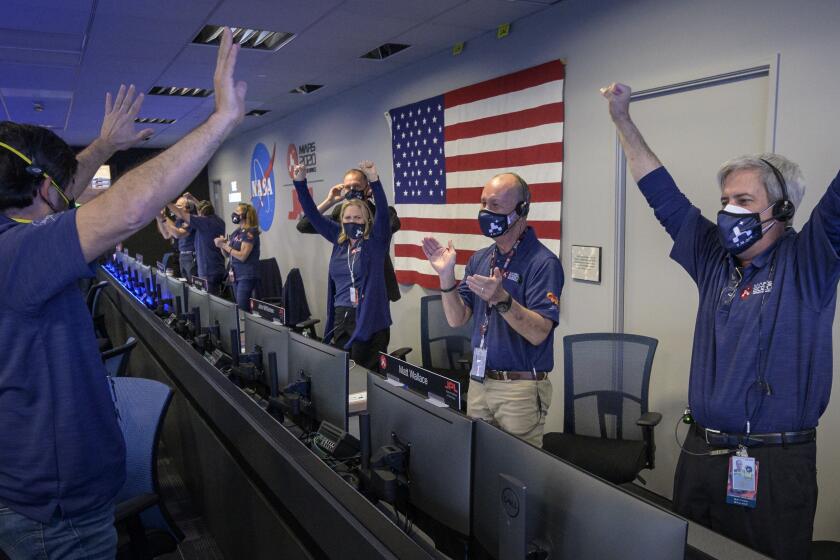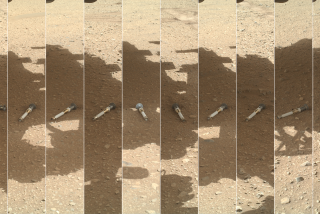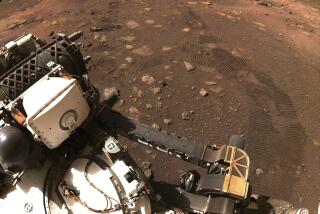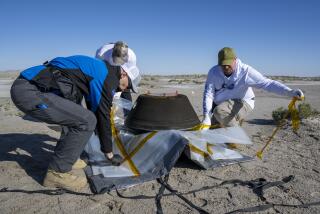NASA shares bird’s-eye view of Perseverance landing on Mars
- Share via
Now that’s what you call a photo finish.
NASA’s Mars 2020 spacecraft has sent back a striking image of the Perseverance rover suspended several feet above the red planet’s surface, just as it’s about to set down its six wheels in Jezero Crater.
The image shows the rover from above as its rocket-powered descent stage carefully lowers the vehicle to the ground. It’s a stunning shot from the final seconds of a perilous journey to Mars.
The picture was one of several shared Friday by officials at NASA’s Jet Propulsion Laboratory, one day after Perseverance landed on Mars. Among the others showcased: a high-resolution image of the rocks and debris near one of the rover’s six wheels; a full-color image of Jezero Crater with the rover’s shadow looming large; and a shot taken from the Mars Reconnaissance Orbiter of the spacecraft’s descent stage plummeting through the atmosphere, with its supersonic parachute fully deployed.
The images gave the Mars 2020 team members — particularly the engineers — a palpable sense of relief that “Percy,” as the rover is affectionately known, had made the grueling journey in one piece.
“The rover is doing great and is healthy on the surface of Mars and continues to be highly functional and awesome and just — I’m exhilarated,” said Pauline Hwang, Mars 2020’s assistant strategic mission manager.
Perseverance is bristling with 23 cameras, and it put a number of them to good use documenting its journey while navigating to a safe, flat spot in Jezero Crater, whose sharp rocks, sand dunes and steep cliffs once made it an unthinkable landing spot. But this danger zone is also a perfect spot for the rover to look for signs of ancient microbial life: The crater hosts an ancient delta where water would have rushed into a long-gone lake, depositing sediments that could hold telltale biosignatures.
If NASA’s Perseverance rover lands safely on Mars, it will become the first space mission in nearly 45 years to directly search for signs of microbial life.
Many more images are on the way, officials said. Most of the rover’s cameras can take pictures in color, and many can shoot video.
In addition, onboard microphones may have captured the first audio recordings from a Martian rover descent. Some of those initial data are expected to be relayed to Earth and processed over the weekend, officials said.
“Our team has been working up until 5 o’clock this morning and will continue to be working hours like this over the weekend” in order to process and publish the data quickly, said Hallie Gengl, instrument data systems operation lead for NASA’s Multimission Image-Processing Laboratory.
The rover will be spending several days checking its systems and switching its software over to surface operations. It’s expected to raise its “head,” or mast, on Saturday, allowing it to take panoramas of the rover’s deck and its surroundings. The earliest Percy’s handlers could try a short first drive might be around sol nine — or Martian day nine — of the mission, Hwang said. (Martian sols are roughly 39 minutes longer than Earth days, so the two slowly move out of sync as the mission continues.)
A JPL scientist’s family joins him on his mission to live sol by sol -- and discovers a new sort of life around Los Angeles.
And somewhere around sol 60 — “maybe a little bit earlier if we’re super fast” — the Ingenuity helicopter that hitched a ride to the planet with Perseverance might be ready to take its first flight.
Kathryn Stack Morgan, Mars 2020’s deputy project scientist, said the science team had already started to get its bearings in Perseverance’s forever home. The rover has landed in a deposit full of a mineral called olivine, and the researchers are trying to figure out how it evolved. It could be the remains of an explosive ash deposit, or it could be sediments from an ancient lake basin.
“In order to figure this out we really need to get our cameras turned on, we need to take images of the rocks, and we need to get compositions back,” Stack Morgan said.
NASA’s newest rover touched down safely on the surface of Mars in Jezero Crater
Figuring out the exact age of Martian rock is often difficult, but Stack Morgan said the researchers believe Jezero Crater is about 3.8 billion to 3.9 billion years old. That means the deposits are a little bit younger than that, perhaps somewhere between 3.6 billion and 3.8 billion years old.
“This is the time in Mars history when water was stable on the surface of Mars, and we think this area would have been a habitable environment,” Stack Morgan said. “And so as soon as we nail down that depositional interpretation, we can really start to evaluate the habitability of the rocks that we have in front of us.”
That age-dating issue is one reason why a strange, hole-studded rock in one of the images captured by one of Percy’s hazard avoidance cameras caught the eyes of mission scientists.
Such holey rocks are often volcanic — not the kind to have trapped signs of possible microbes on Mars. But volcanic rocks are very useful for age-dating Mars, Stack Morgan said.
On the other hand, there’s a chance the hole-filled rock is sedimentary, and fluids moving through it have dissolved certain parts within, leaving the cavities behind.
Either way, Stack Morgan said, geologists will learn something new about Mars — which makes it a win-win for the science team.








